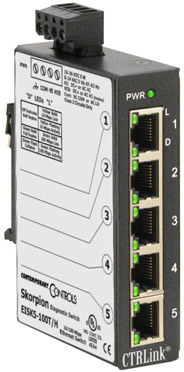Control Network Newsletter

When is an Ethernet Hub Better than an Ethernet Switch?
 February 2011 - For those who follow our writings on the Industrial Ethernet University, you know we promote Ethernet switches as the best way to expand Ethernet networks. Although Ethernet hubs can be used, Ethernet switches do much more. Switches can operate at multiple data rates, operate at either half- or full-duplex, and can automatically set speed and duplex using the auto-negotiation protocol. Switches improve throughput by restricting directed message traffic to only those ports on the switch that are party to the communication. All other ports not involved with the communication will not see the message. This feature is accomplished through a learning process where the switch records in its database the port location of all initiating station addresses. Once port-address locations are learned, communication is streamlined to just two ports on the switch for a particular directed message.
February 2011 - For those who follow our writings on the Industrial Ethernet University, you know we promote Ethernet switches as the best way to expand Ethernet networks. Although Ethernet hubs can be used, Ethernet switches do much more. Switches can operate at multiple data rates, operate at either half- or full-duplex, and can automatically set speed and duplex using the auto-negotiation protocol. Switches improve throughput by restricting directed message traffic to only those ports on the switch that are party to the communication. All other ports not involved with the communication will not see the message. This feature is accomplished through a learning process where the switch records in its database the port location of all initiating station addresses. Once port-address locations are learned, communication is streamlined to just two ports on the switch for a particular directed message.
This is a wonderful feature except in one situation – you are at a plugfest and you are doing protocol diagnostics with tools such as Wire Shark. In that situation, hubs have a particular feature that is important for network diagnostics, making a hub a better option than a switch.
Because Ethernet hubs operate at one speed and only at half-duplex in what is called Shared Ethernet, they do not understand the concept of station addresses. With Shared Ethernet, all hub ports will repeat the same message received on one of its ports. That means a diagnostic tool connected to any unused hub port can view all the traffic sent over the network. A switch will restrict port traffic and cause a diagnostic tool to fail to see messages except for broadcast messages. Although it is possible to use port mirroring on the switch, this feature is usually only found on higher-end switches and there is no guarantee that it can capture all data.
If you are doing protocol diagnostics at a plugfest, a hub is a better than a switch, but hubs are difficult to find. Contemporary Controls' solution is the EISK5-100T/H Skorpion Diagnostic Switch. Although it has identical features to its cousin the EISK5-100T Skorpion 5-port switch it is missing one key feature – it does not learn. If a switch does not learn, it does not know the destination port of a directed message so it floods all ports with the message as if it was a broadcast message. This allows the diagnostic tool to be connected to any unused port. If more than five ports are needed, Diagnostic Switches can be cascaded with no loss of data.
The Diagnostic Switch is even better than a hub because the other features of switches are preserved – ability of all connected stations to operate at different speeds and duplex. Visit the 5-port Skorpion Diagnostic Swith product page to learn more.